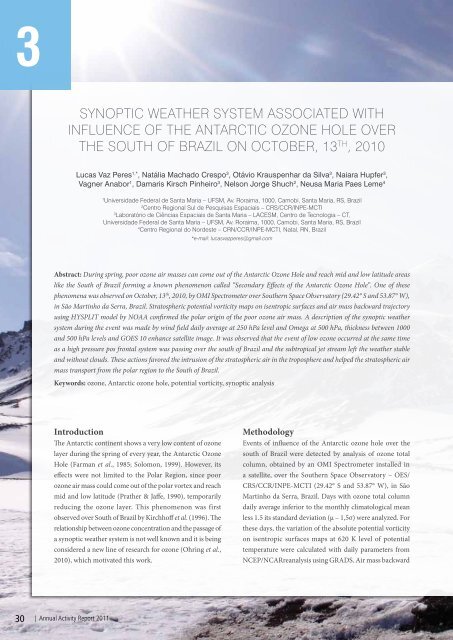1 - Instituto de Biologia da UFRJ
1 - Instituto de Biologia da UFRJ
1 - Instituto de Biologia da UFRJ
You also want an ePaper? Increase the reach of your titles
YUMPU automatically turns print PDFs into web optimized ePapers that Google loves.
3<br />
SYNOPTIC WEATHER SYSTEM ASSOCIATED WITH<br />
INFLUENCE OF THE ANTARCTIC OZONE HOLE OVER<br />
THE SOUTH OF BRAZIL ON OCTOBER, 13 th , 2010<br />
Lucas Vaz Peres 1,* , Natália Machado Crespo 3 , Otávio Krauspenhar <strong>da</strong> Silva 3 , Naiara Hupfer 3 ,<br />
Vagner Anabor 1 , Damaris Kirsch Pinheiro 3 , Nelson Jorge Shuch 2 , Neusa Maria Paes Leme 4<br />
1<br />
Universi<strong>da</strong><strong>de</strong> Fe<strong>de</strong>ral <strong>de</strong> Santa Maria – UFSM, Av. Roraima, 1000, Camobi, Santa Maria, RS, Brazil<br />
2<br />
Centro Regional Sul <strong>de</strong> Pesquisas Espaciais – CRS/CCR/INPE-MCTI<br />
3<br />
Laboratório <strong>de</strong> Ciências Espaciais <strong>de</strong> Santa Maria – LACESM, Centro <strong>de</strong> Tecnologia – CT,<br />
Universi<strong>da</strong><strong>de</strong> Fe<strong>de</strong>ral <strong>de</strong> Santa Maria – UFSM, Av. Roraima, 1000, Camobi, Santa Maria, RS, Brazil<br />
4<br />
Centro Regional do Nor<strong>de</strong>ste – CRN/CCR/INPE-MCTI, Natal, RN, Brazil<br />
*e-mail: lucasvazperes@gmail.com<br />
Abstract: During spring, poor ozone air masses can come out of the Antarctic Ozone Hole and reach mid and low latitu<strong>de</strong> areas<br />
like the South of Brazil forming a known phenomenon called “Secon<strong>da</strong>ry Effects of the Antarctic Ozone Hole”. One of these<br />
phenomena was observed on October, 13 th , 2010, by OMI Spectrometer over Southern Space Observatory (29.42° S and 53.87° W),<br />
in São Martinho <strong>da</strong> Serra, Brazil. Stratospheric potential vorticity maps on isentropic surfaces and air mass backward trajectory<br />
using HYSPLIT mo<strong>de</strong>l by NOAA confirmed the polar origin of the poor ozone air mass. A <strong>de</strong>scription of the synoptic weather<br />
system during the event was ma<strong>de</strong> by wind field <strong>da</strong>ily average at 250 hPa level and Omega at 500 hPa, thickness between 1000<br />
and 500 hPa levels and GOES 10 enhance satellite image. It was observed that the event of low ozone occurred at the same time<br />
as a high pressure pos frontal system was passing over the south of Brazil and the subtropical jet stream left the weather stable<br />
and without clouds. These actions favored the intrusion of the stratospheric air in the troposphere and helped the stratospheric air<br />
mass transport from the polar region to the South of Brazil.<br />
Keywords: ozone, Antarctic ozone hole, potential vorticity, synoptic analysis<br />
Introduction<br />
The Antarctic continent shows a very low content of ozone<br />
layer during the spring of every year, the Antarctic Ozone<br />
Hole (Farman et al., 1985; Solomon, 1999). However, its<br />
effects were not limited to the Polar Region, since poor<br />
ozone air mass could come out of the polar vortex and reach<br />
mid and low latitu<strong>de</strong> (Prather & Jaffe, 1990), temporarily<br />
reducing the ozone layer. This phenomenon was first<br />
observed over South of Brazil by Kirchhoff et al. (1996). The<br />
relationship between ozone concentration and the passage of<br />
a synoptic weather system is not well known and it is being<br />
consi<strong>de</strong>red a new line of research for ozone (Ohring et al.,<br />
2010), which motivated this work.<br />
Methodology<br />
Events of influence of the Antarctic ozone hole over the<br />
south of Brazil were <strong>de</strong>tected by analysis of ozone total<br />
column, obtained by an OMI Spectrometer installed in<br />
a satellite, over the Southern Space Observatory – OES/<br />
CRS/CCR/INPE-MCTI (29.42° S and 53.87° W), in São<br />
Martinho <strong>da</strong> Serra, Brazil. Days with ozone total column<br />
<strong>da</strong>ily average inferior to the monthly climatological mean<br />
less 1.5 its stan<strong>da</strong>rd <strong>de</strong>viation (µ – 1,5σ) were analyzed. For<br />
these <strong>da</strong>ys, the variation of the absolute potential vorticity<br />
on isentropic surfaces maps at 620 K level of potential<br />
temperature were calculated with <strong>da</strong>ily parameters from<br />
NCEP/NCARreanalysis using GRADS. Air mass backward<br />
30 | Annual Activity Report 2011

















